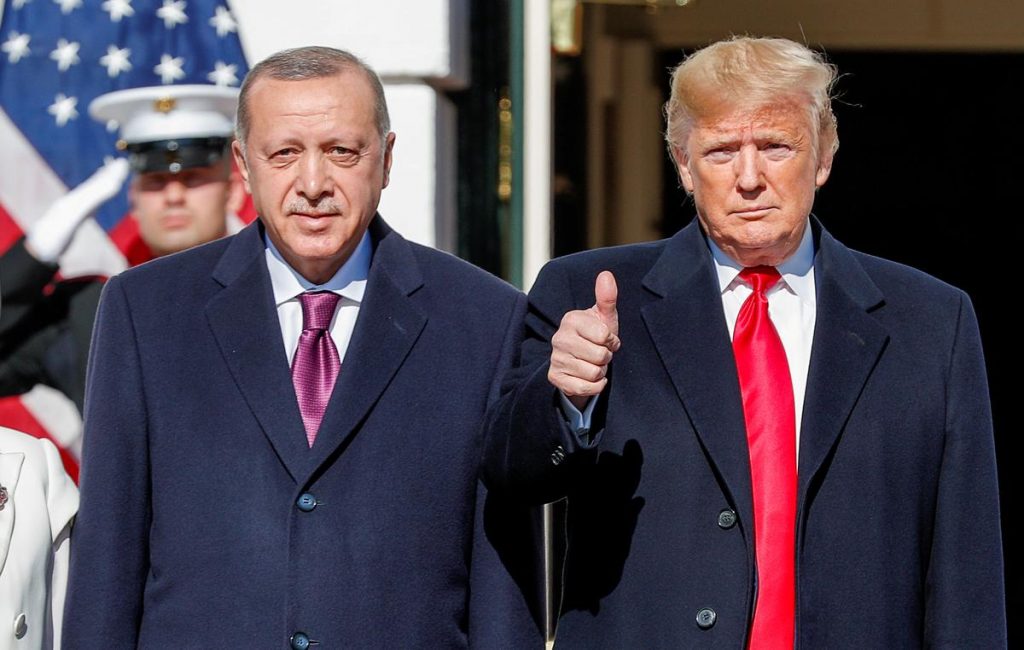
- ARAB NEWS
- 04 Jul 2025

Turkish President Recep Tayyip Erdogan has every reason to be pleased with his visit to Washington last week. His host, US President Donald Trump, described himself as a “big fan” of Erdogan and called him a “great president.” Trump even took into his stride Erdogan’s public criticism of the presidential invitation to the Syrian Kurd leader Mazloum Kobani, whom Erdogan describes as a terrorist, and the Turkish president’s revelation that he had returned Trump’s “insulting” letter calling on him to desist from attacking the Kurds in Syria.
Erdogan’s sojourn in the US capital has been described as a “diplomatic triumph” largely because it took place in the most unpropitious of circumstances. Trump’s officials and several influential Congress members did not even want it to take place. A month earlier, the House of Representatives had passed by 354 votes to 60 a resolution condemning Turkey’s invasion of Syria. Some representatives noted that Turkey’s Arab allies might have committed war crimes during the invasion.
On Oct. 29, the House also passed a nonbinding resolution describing the killings of Armenians by Turkish forces in 1915 to 1923 as genocide, though after Erdogan’s visit Sen. Lindsey Graham said he would block it in the Senate.
Within the administration, the Pentagon was incensed with its NATO partner: Not only had Turkey purchased the Russian S-400 missile system, it was also discussing with Moscow the possibility of buying the Su-35 fighter plane to make up for its expulsion from the F-35 aircraft project. Congress has been calling for sanctions on Turkey to punish these blossoming relations with Russia, which Trump has robustly resisted.
The Washington success marks the culmination of much that has been going right for Erdogan. After Trump directed US troops to withdraw from a section of the Turkey-Syria border on Oct. 6, Turkish forces took just two weeks to expel the Kurds and create a “safe zone” that was 120 kilometers long and 30 kilometers deep, covering the territory from Tal Abyad to Ras Al-Ayn.
Later, Turkey was backed by Russia. At the Vladimir Putin-Erdogan summit at Sochi on Oct. 22, the “Sochi Memorandum” endorsed the “status quo” in this enclave. This affirmed Russian backing for the Turkish military occupation and the removal of militants of the Kurdish People’s Protection Units (YPG).
This enclave will enable Turkey to begin relocating a large proportion of the 3.6 million Syrian refugees it currently hosts. Turkey has also said that it will send home the hundreds of foreign Daesh fighters who are now in its custody.
All this reflects the success of “Operation Peace Spring” from the Turkish perspective. Turkey’s military operation liquidated several hundred Kurdish fighters, while ensuring that this zone will be jointly patrolled by Russian and Turkish forces to keep the Kurds from returning. Russia also agreed that YPG militants would be removed from the region currently under joint Syrian-Russian control, including the towns of Manbij and Tal Rifaat.
However, Ankara must be wary of pushing its luck, as Foreign Minister Mevlut Cavusoglu’s suggestion this week of a further military action against the YPG brought a withering response from the Kremlin.
The Turkish military’s recent success also brought Trump on to Erdogan’s side, since it enabled the US president to proclaim that the cease-fire from Oct. 23 was entirely the result of Washington’s efforts.
However, the State and Defense Departments were able to get their president to agree to retain some 500 to 600 US troops to guard the oil fields in Deir Ezzor to ensure that their revenues did not go to the Syrian government. Despite this, most observers still believe that Trump’s priority is to get all US troops out of Syria.
The outlook relating to the Syrian scenario remains uncertain. Divisions at the heart of the US administration did not allow Erdogan and Trump to address the important outstanding issues relating to Syria: Turkey-US differences relating to burgeoning Turkish-Russian relations, the US’ own ties with the Kurds, and its future presence in Syria.
Erdogan told Parliament on Tuesday that he insisted to Trump that Turkey would not back down from its purchase of the S-400 missile system. And the Pentagon is aware that it will not be easy to remove Turkey from the F-35 project: No replacements have been found for at least 12 crucial components being developed by Turkish companies.
The US president’s green light to the Turkish invasion has already dealt a body-blow to US credibility among the Kurds and has encouraged them to turn to the Russians. Moscow is encouraging them to cooperate with the Syrian government — a joint Syrian-Russian military presence in Kurdish areas outside the Turkish enclave will boost their confidence.
Russia’s principal effort now will be to promote engagement between Turkey and the Syrian government. The Sochi Memorandum gave considerable importance to the Turkey-Syria Adana agreement of October 1998 and the Agreement on Joint Cooperation against Terrorism of December 2010 as the bases for their future rapprochement.
While they have a long way to go and their interactions will meet several obstacles, over the long-term the three states — Syria, Turkey and Russia — will be brought together by their shared interests in reconstruction projects in Syria and joint development of the energy potential of the Eastern Mediterranean. The US does not have a place in this scenario.
Talmiz Ahmad is an author and former Indian ambassador to Saudi Arabia, Oman and the UAE. He holds the Ram Sathe Chair for International Studies, Symbiosis International University, Pune, India.